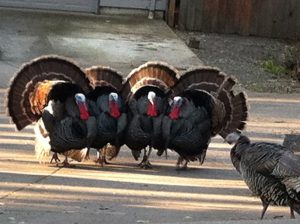Last spring, I was driving my dog to doggie day care and came upon this hilarious scene in a neighbor’s driveway. I had to pull over and snap a quick photo from my phone.

Everyone I’ve shown this to gets a big kick out of it, so I thought I’d share it with you.
What do these turkeys have in common with your pet business or veterinary practice website?
And what lessons can be learned from this photo when it comes to optimizing the images on your site?
I see 2 key take-aways for you.
1. Try to use distinct images for marketing your pet products or services.
This quartet of Tom turkeys are strutting their stuff in full regalia to attract the lone female who happens to be strolling by. Sadly, it’s hard to tell them apart, except the one on the right has some torn tail issues.
So how does the female know which one is her soul mate, or if any of them belong by her side? Hmmm. I wish I knew how that works. All I know is, it leads to an important point.
The lesson for your pet website is: If you use generic stock images on your website, chances are those images are found on many other sites in your category!
For example, right now, there’s a stock image of a Westie dog sitting in a green, grassy field, and he has one ear cocked. I see that photo EVERYWHERE, on all kinds of pet-related websites and even product packaging.
Another popular stock image shows a boxer using a laptop. It’s very cute because the boxer is wearing glasses and holding the mouse, as if he’s truly surfing the Internet.
While these photos are terrific, using popular stock images can cause problems when your company is trying to set itself apart from others. It could actually be confusing. The customer may think, “Where have I seen that image before? Oh, yeah. In my veterinarian’s office – on a poster.” Or, “in the latest dog food ad for Brand X.” Oops.
Whenever possible, use images that are distinctly yours. It’s well worth the investment, and you can see from my turkeys that sometimes it doesn’t take a fancy camera or expensive production to get a cool photo.
2. Optimize your images for your visitors and for search engines.
When you add an image to your website, there’s an opportunity to include content that adds clarity for your visitors and Google, Bing, etc. For instance, WordPress offers the following fields for you to fill in when you upload an image:
- Title: The default is a code number that is not descriptive. You can change this to a short description with a keyword, such as “Reflective dog leash color options.”
- Alternative text: Here’s your chance to write a brief description of the product benefits, using keywords. I made up this fictitious example to give you an idea — “At Dolly’s Dog Products.com, we offer 3 reflective dog leash color options: safety orange, neon green, and vivid blue.”
- Caption: Every image on your website should include a descriptive caption that helps the “scanning” visitors instantly see what the photo has to do with your topic. For this particular blog post, my photo caption is, “Turkey lessons about optimizing your pet website images.” Make sure your photo and caption are 100% relevant to the topic you’re discussing on the page.
Those are just two lessons these turkeys can teach you. You can also include quirky animal photos that have sharing power, or use your own images of a pet using your product, etc. Photos can be extremely powerful – so go for it!
Until next time,
Here’s to a prosperous pet business website!
Cheers,
Pam Foster, PetCopywriter.com
